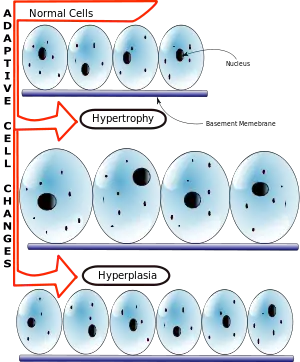Hypertrophy
Hypertrophy is the increase in the volume of an organ or tissue due to the enlargement of its component cells.[1] It is distinguished from hyperplasia, in which the cells remain approximately the same size but increase in number.[2] Although hypertrophy and hyperplasia are two distinct processes, they frequently occur together, such as in the case of the hormonally-induced proliferation and enlargement of the cells of the uterus during pregnancy.
| Hypertrophy | |
|---|---|
 | |
| Hypertrophy results from an increase in cell size, whereas hyperplasia stems from an increase in cell number |
Eccentric hypertrophy is a type of hypertrophy where the walls and chamber of a hollow organ undergo growth in which the overall size and volume are enlarged. It is applied especially to the left ventricle of heart.[3] Sarcomeres are added in series, as for example in dilated cardiomyopathy (in contrast to hypertrophic cardiomyopathy, a type of concentric hypertrophy, where sarcomeres are added in parallel).
Gallery
 Hypertrophy of breast, c. 1870
Hypertrophy of breast, c. 1870 Forensic post-mortem examination of a case of hypertrophic cardiomyopathy, showing thickening of the cardiac muscle
Forensic post-mortem examination of a case of hypertrophic cardiomyopathy, showing thickening of the cardiac muscle Kidney hypertrophy
Kidney hypertrophy Hypertrophy of the ear (macrotia)
Hypertrophy of the ear (macrotia) Hypertrophy of the temporal muscles
Hypertrophy of the temporal muscles
| -plasia and -trophy |
|---|
|
|
See also
- Athlete's heart
- Ventricular hypertrophy (including left ventricular hypertrophy and right ventricular hypertrophy)
- Muscle hypertrophy
- List of biological development disorders
References
- Hernandez, Richard; Kravitz, Len. "Skeletal muscle hypertrophy". www.unm.edu.
- Updated by Linda J. Vorvick. 8/14/15.Hyperplasia
- Kusumoto, F. M. (2004), Cardiovascular Pathophysiology, Hayes Barton Press, pp. 20–22, ISBN 978-1-59377-189-8
External links
- University of California Muscle Physiology Home Page: Hypertrophy Archived 2021-04-21 at the Wayback Machine